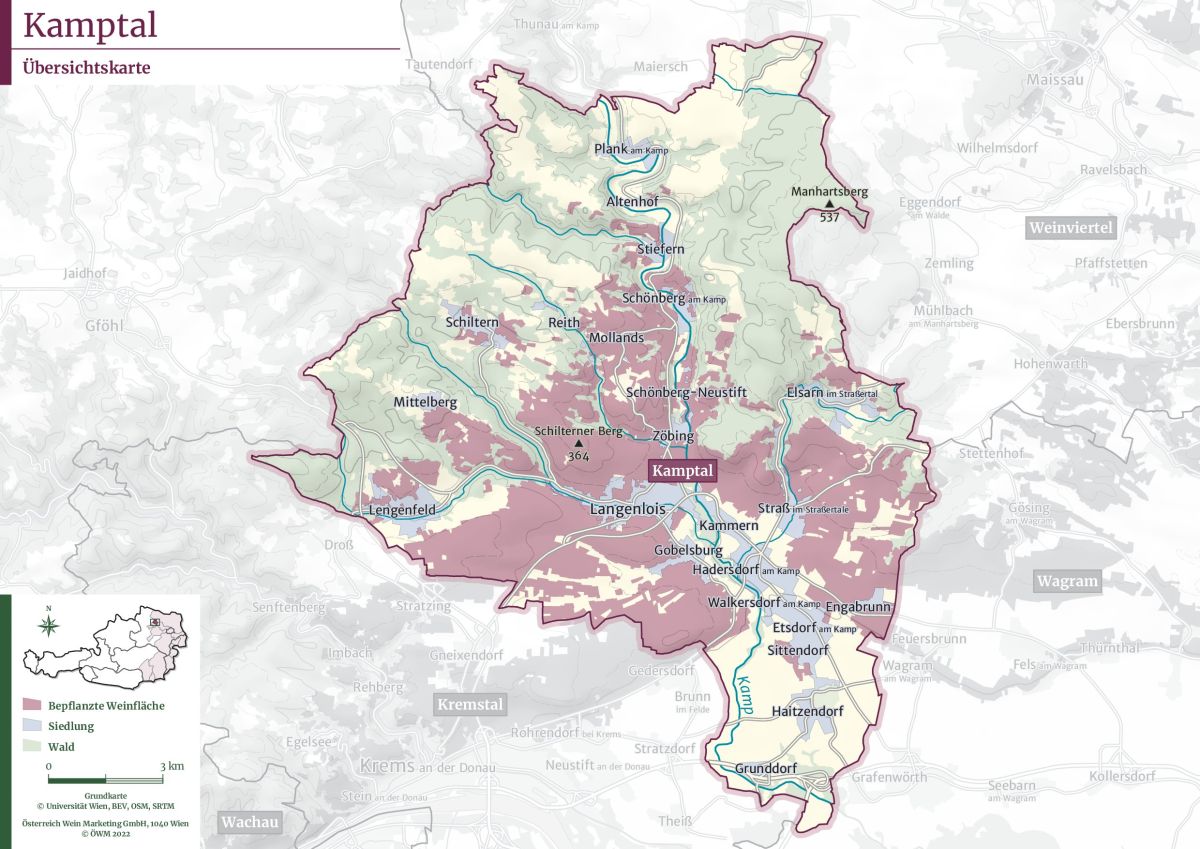Since the 2008 vintage, wine-legally defined DAC area (specific wine-growing region) in the Austrian wine-growing region of Lower Austria (generic wine-growing region). See under Kamptal.
Kamptal
One of the eight specific wine-growing regions in the Austrian federal state or generic wine-growing region of Lower Austria. The name was given to the area west of Vienna by the 153 kilometre long Kamp river, which flows through it from Schönberg in the north to Hadersdorf in the south and flows into the Danube near Krems. There is evidence of viticulture here since at least the early Middle Ages. Until 1993, the two now independent wine-growing regions of Kamptal and Kremstal were united under the name Kamptal-Donauland.

Climate & soils
The predominant soil types are loam, loess, gravel and primary rock soils. The climate is characterised by hot, Pannonian influences and cool currents from the Waldviertel. The amount of precipitation is rather low; there is often fog in spring, autumn and winter. A special feature is the famous Heiligenstein near Zöbing-Langenlois, made of desert sandstone with volcanic elements, whose name refers to the "hellish" solar radiation (exposure) with a hot, dry microclimate. The alternation between hot days and cool nights gives the wines lively acidity.
Wine-growing communities
The wine-growing centre of the Kamptal wine-growing region is the largest Austrian wine-growing municipality in terms of vineyard area, Langenlois, with the cadastral municipalities of Gobelsburg, Haindorf and Zöbing. Other municipalities are Etsdorf, Hadersdorf, Kammern, Lengenfeld, Schönberg, Sittendorf, Straß im Straßertale and Walkersdorf. The best-known vineyard is the above-mentioned Zöbinger Heiligenstein; others are Bleckenweg, Gaisberg, Grub, Dechant, Fahnberg, Fraupoint, Hasel, Hiesberg, Käferberg, Kalvarienberg, Kogelberg, Ladner, Lamm, Letten, Loiserberg, Liß, Panzaun, Sauberg, Schenkenbichl, Seeberg, Spiegel, Sonnwendberg, Stangl, Steinhaus, Steinmassl, Tagler and Wechselberg.

Grape variety index
In 2022, the vineyards covered a total of 3,574 hectares of vines. Compared to 2015 with 3,907 hectares, this was a reduction of 333 hectares (8.5%). The proportion of red wine varieties is 19%, the proportion of white wine varieties 81%. It dominates undisputedly with over half of the stock Grüner Veltliner, followed by Zweigelt, Riesling and Müller-Thurgau.
Grape variety
|
in Austria
|
colour |
HA
|
%
|
HA
|
%
|
| Grüner Veltliner | White plum | white | 1.965 | 55,0 | 1.982 | 50,7 |
| Zweigelt | Blauer Zweigelt, Rotburger | red | 456 | 12,8 | 520 | 13,3 |
| White Riesling | Riesling Rhine Riesling | white | 361 | 10,1 | 397 | 10,2 |
| Müller-Thurgau | Rivaner | white | 149 | 4,1 | 243 | 6,2 |
| Chardonnay | Morillon - not used in Lower Austria | white | 97 | 2,4 | 87 | 2,2 |
| Pinot Blanc | Pinot Blanc, Klevner | white | 79 | 2,2 | 85 | 2,2 |
| Muscat | Yellow M., Red M. / Muscat Blanc | white | 72 | 2,0 | 50 | 1,3 |
| Frühroter Veltliner | Malvasia | white | 45 | 1,3 | 60 | 1,5 |
| Sauvignon BlancSauvignon... |
Voices of our members

There is a vast number of sources on the web where one can acquire knowledge about wine. But none has the scope, timeliness and accuracy of the information in the encyclopaedia at wein.plus. I use it regularly and rely on it.
Sigi Hiss
freier Autor und Weinberater (Fine, Vinum u.a.), Bad Krozingen